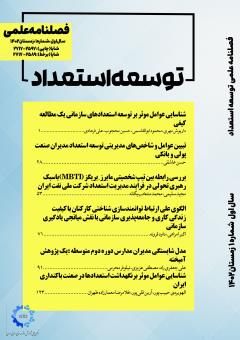مدل شایستگی مدیران مدارس دوره دوم متوسطه: یک پژوهش آمیخته
محورهای موضوعی : مدل های شایستگی و اثرگذاری آنها بر توسعه توانمندی های سرمایه های انسانیعلی جعفری راد 1 , مصطفی عزیزی 2 , نیلوفر محرمی 3
1 - دانشگاه آزاد اسلامی
2 - عضو هیات علمی دانشگاه مازندران
3 - دانشجوی کارشناسی ارشد دانشگاه مازندران
کلید واژه: توسعه حرفه ای, شایستگی, مدل یابی, مدیران مدارس,
چکیده مقاله :
پژوهش حاضر با هدف طراحی الگویی مفهومی و اعتباریابی آن برای شایستگی مدیران مدارس متوسطه انجام گرفت. بدین منظور از روش تحقیق آمیخته استفاده شد. در بخش کیفی نمونه ای هدفمند متشکل از 17 نفر از اعضای هیأت علمی، مدیران ستادی و برخی از مدیران مدارس که بطور بالقوه بیشترین اطلاعات را در خصوص شایستگی مدیران داشتند، انتخاب شدند. دیدگاه های افراد از طریق مصاحبه نیمه ساختاریافته بدست آمد و جهت تحلیل اطلاعات از روش کدگذاری استفاده شد. یافته ها به صورت 6 مقوله اصلی شامل پدیده محوری، عوامل علیّ، عوامل زمینه ای، عوامل مداخله گر، استراتژی ها و پیامدها و 17 مقوله کلی که در پژوهش بدان پرداخته شده است، مشخص گردید. بر مبنای یافته های کیفی پرسشنامه ای محقق ساخته طراحی و بر روی نمونه ای متشکل از 336 نفر از مدیران مدارس متوسطه دوم شهر تهران اجرا شد. یافته های کمی نشان داد، مقادیر ضریب تاثیر در مدل اندازه گیری شایستگی مدیران، عوامل علیّ- پدیده محوری (0.137)؛ عوامل زمینه ای- پدیده محوری (0.818)؛ عوامل مداخله گر- پدیده محوری (0.162)؛ پدیده محوری- استراتژی ها (0.877) و استراتژی ها- پیامدها (0.896) مطلوب می باشد. از طرفی، مقدار t متناظر با هر ضریب بیشتر از مقدار بحرانی آن (1.96) و در سطح 0.05 معنادار است. در نهایت مدل شایستگی، متشکل از عوامل و مؤلفه های موثر بر شایستگی مدیران مدارس دوره دوم متوسطه به عنوان چارچوب و راهنمای عمل دست اندرکاران آموزش و پرورش جهت گزینش مدیران ترسیم گردید.
This study was conducted to design and validate the conceptual model of competence of high school principals in Tehran. For this purpose, a qualitative and quantitative mixed method was used. In the qualitative section, a purposive sample of 17 faculty members, department heads of the Ministry of Education, and some school principals who potentially had the most information about principals' competence were selected. Individuals' views were obtained through semi-structured interviews and open, axial and selective coding was used to analyze the data. The results of the analysis were extracted into 6 main categories including core phenomena, causal factors, contextual factors, interfering factors, strategies and outcomes, and 17 general categories that were addressed in the study. Based on the findings of the qualitative part, a researcher-made questionnaire was designed and was conducted to a sample of 336 secondary school principals in Tehran. Results in quantitative section showed that impact factor values in manager competency measurement model, causal factors- core phenomena (0.137); contextual factors- core phenomena (0.818); interfering factors-core phenomena (0.162); core phenomena- strategies (0.877) and strategies-outcomes (0.896) are desirable. On the other hand, the value of t corresponding to each coefficient is greater than its critical value (1.96) at the significant level of 0.05. Finally, the competency model consisted of factors and components affecting the competence of secondary school principals as a framework and practice guide for education practitioners to select principals.
